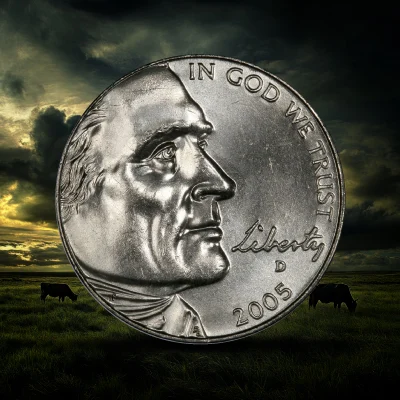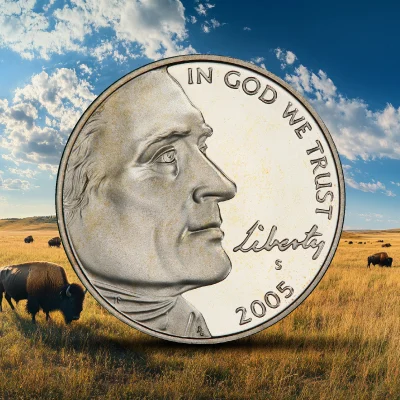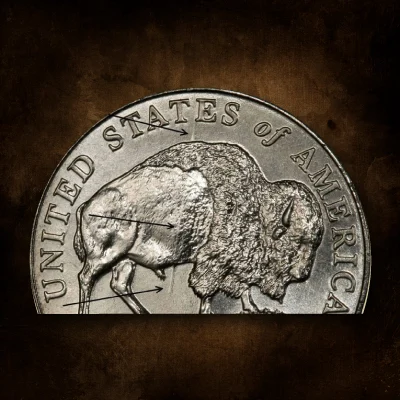
In the world of the most valuable collectible coins, who would think that a 2005 dated, 5 cents coin can be worth around $300 and possibly more? The nickels are US currency coins comprising 25% Nickel and 75% Copper and have been struck since 1866. If you have the Jefferson Nickel with the right key date, you can be holding onto a pocket treasure.
Today, we will discuss precisely the 2005 Jefferson Nickel, also termed as the 2005 Buffalo Nickel.
The article discusses the features of the 2005 Buffalo Nickel, its values, the list of errors, and why and how the condition, grade, and mint marks influence the value of the coin overall. The 2005 Buffalo Nickel was a combination of the Jefferson Nickel and the Buffalo Nickel released in 2004 and 2005 that honored the bicentennial of the Lewis and Clark Expedition.
Thus, the 2005 Buffalo Nickel features the effigy of Thomas Jefferson on the obverse and the American bison on the reverse, with the respective identifying marks like the face value, year of issue, the US mottos, and the mint mark.
Let’s discuss this in detail!
The design of the 2005 Buffalo nickel is what makes the coin rare and special that it is. The obverse that features a iconic bust of the President was struck only for that year. The design was sculpted by Joe Fitzgerald based on Houdon's bust of Jefferson.

The obverse features the bust of President Thomas Jefferson facing right for the first time in the history of the Jefferson Nickels. The design also includes the US motto, “IN GOD WE TRUST,” the year of issue “, 2005,” the mint mark, and the word “LIBERTY,” which is said to be traced directly from handwriting from Thomas Jefferson’s in drafting the Declaration of Independence; as the word is never capitalized in that document, Fitzgerald borrowed a capital L from Jefferson's other writings.

The reverse side of the 2005 buffalo nickel is the return of the original buffalo nickel design. This sight is one of the ages that brings the commemorative design and the specimen of history’s greatest hits. This design depicts the iconic Black Diamond Bison from the Central Park Zoo, that was originally featured on the Buffalo Nickel from 1913.
The inscriptions include the country of issue, “UNITED STATES OF AMERICA,” with the US motto, “E PLURIBUS UNUM,” and the face value, “FIVE CENTS.”
| Other Specifications | ||||
|---|---|---|---|---|
| Year of issue | 2005 | |||
| Face value | 5 Cents | |||
| Composition | 75% Copper, 25% Nickel | |||
| Weight | 5.00 grams | |||
| Diameter | 21.21 mm | |||
| Thickness | 1.95 mm | |||
| Edge | Plain | |||
| Mintmarks | Philadelphia (no mint mark), Denver (D), San Franscisco (S) | |||
The grading of the coin is one of the most influential factors that determine the value and pricing of the coin. The grading of the coin includes the condition, which is categorised as Uncirculated, Extremely Fine, Fine, and Good. The condition of the coin corresponds with the grading scale followed and designated by the coin grading services like, Professional Coin Grading Service (PCGS) and Numismatic Guaranty Company (NGC).
Here’s a table that gives a comprehensive understanding of the condition and grading:
Still don’t feel that these nickels are valued enough? Wait until you know about the rare errors that can make the values skyrocket like a skyscraper. Having a rare error can take up the value to a few hundred to thousand dollars!
Here’s a detailed description of each one:

This is one of the valuable nickel erros but it is a quite common error in the history of nickels. This error occurs when the die strikes the planchet multiple times at different angles, that results in overlapped or doubled inscriptions or design features.
Even though it is common, the collectors pay a good amount for it. For an instance, a collector paid $993 for the same 2005 D Jefferson nickel with the MS66 grade with this error on the obverse and the reverse.
This error appears to be a close, lateral, lines on the coin’s surface that occurs from the die strikes the feeder fingers which leaves the its impression on the planchet. In the general cases, the feeder fingers would automatically retract themselves after the die strikes the coin, but sometimes they can be slow or do not completely retract making them leave an impression on the coin design.
This coin error is valued based on the intensity of the impression of the feeder finger. Like in 2022, a collector on eBay paid $1,010 for the 2005 P Nickel with the MS65 grade. This error coin can even fetch more than this and can potentially be one of the most valuable nickels in history.

In the striking process, the dies are reguarly adjusted by workers to ensure proper contact with the planchet. However, when the adjustment isn’t done correctly the die doesn’t apply the required pressure, resulting in a weak strike. This error is generally known as the die adjustment error.
In 2023, one of the 2005 D MS65 Jefferson Buffalo Nickel Die Adjustment Error coin was paid for $845 for it.

The struck-through is a well-known and rare error in the bullion and collectible coin worlds. The strike through error occurs when an object is accidentally struck between the die and planchet that leaves an impression of the object on the coin design.
This object would be anything that ranges from a feather, pieces of cloth, strands of hair, pieces of metals, or even an organism. This error can be worth a great premium depending on the visibility of the error and the condition of the coin. In 2022, a 2005-P nickel graded MS64 with an obverse strike-through error for $620 at Heritage Auctions.

The 2005-P MS63 Buffalo Jefferson Nickel Die Crack Error coin is an error that appears with a crack or breakage on the coin’s surface. While it is a crack, it gets eventually filled with metal pieces during the striking process. Lastly, the coin depicts a raised crack and may appear anywhere on the coin’s surface.
In 2023, at the Great Collections auctioned a large obverse die crack error on a 2005-P nickel graded MS63 for an impressive $880.

The red improperly annealed planchet bison nickel error is caused when the planchet is exposed to excessive heating or cooling in the annealing chambers. The term “Annealing” means the heating and cooling process planchet under go in preparation for striking.
In 2023, a collector paid $725 for this 2005-D nickel graded MS62 with a red improperly annealed planchet error.

This is the missing clad layer error, which as the moniker suggest, is an upper clad layer on the coin is missing due to lamination issue. The clad layers resulting in bubbling, cracking, and peeling are weakened due to the presence of impurities.
Once more, the value of the clad layer error can be valuable. In 2023, a collector went ahead to pay $635 for a 2005-P nickel graded MS60 with a missing clad layer error on the obverse.

This 2005 Clipped planchet is among the most dramatic and sought-after minting errors in the Jefferson nickel collection. In this error, the clipped planchet has one or more planchets of edge missing. In this case, the clipped planchet visibility hampers the value of the nickel.
In 2021, Heritage Auctions sold a 2005-P MS64 Double Clip Planchet Bison Nickel Error for a staggering $1250, making it one of the most valuable nickels with errors.
In 2005, the Buffalo Nickels were struck in the three mints that are Philadelphia, Denver, and San Francisco. A total number of 939,344,679 commemorative buffalo nickels. Due to such a higher number of mintage, these coins were generally valued for it’s face value.

The “P” mint mark in the Jefferson Buffalo Nickel, 2005, depicts that the coin was minted in the Philadelphia mint coins of the US Mint. In this facility, a total number of 448,320,000 nickels were struck in 2005.
Such a high mintage results in the value not more than its face value. However, when the condition is uncirculated or mint-state, the coin’s costs even more. From MS63 to MS67, the coin value ranges from $5 to $1,150.

Similar to the Philadelphia struck versions, the 2005 D Jefferson Buffalo Nickel had a mintage of around 487,680,000 coins. The mintmark of the Jefferson Nickel are generally visible below the word “LIBERTY.” Depending on the condition, the cost of the coin ranges from $0.10 to $175.
Depending on the coin condition and the grades ranging from MS63 to MS66 ranges from $4 to $45.

Lastly, the San Francisco struck Jefferson Buffalo Nickel are present with the mint mark “S.” A total number of 3,344,679 pieces were struck at the San Francisco mint. Alike other versions, the S proof version cost ranges from $0.50 to $30. While the prices for the graded pieces ranges from $1 to $30.

These variaties are actually errors that are rare and have significant value. In this case even, the condition matters when pricing the speared bison value. The speared bison error as the name suggests, a spear that looks like it pierces from the back and comes out of the lower body.
This error coin can cost you around $30 to $60, while in mint state, the coin values can be more expensive and cost from $75 to $700.

One of the more visually striking errors found in the 2005 Buffalo Nickel is what's known as an improperly annealed planchet. During the minting process, coin blanks (called planchets) are heated and cooled to prepare them for striking. But sometimes, things go a bit wrong. If a blank is overheated or not heated evenly, it can come out with unusual coloring—often red, brown, or even black—giving it a burnt or "cooked" look.
At first glance, this might look like post-mint damage, but coin grading services can distinguish between actual mint errors and environmental damage. Improperly annealed planchets are collectible and fairly rare. Depending on the grade and how intense the coloring is, these error nickels can sell for anywhere between $200 and $750. One coin graded MS62 even sold for $725 at auction in 2023.

Another unusual—and pretty well-known—variety is the “detached leg” or “missing leg” error. On some 2005 Buffalo Nickels, you might notice that the bison appears to be missing part of one of its front legs. Don’t worry, it's not a design flaw—it’s actually a struck-through grease error. Grease or debris on the die during minting can prevent parts of the image from striking properly, leading to missing or faded details.
Collectors love this type of error because it's so easy to spot. In circulated condition, a detached leg nickel might fetch $30 to $60, but in higher grades—especially MS64 and above—prices can climb to $100 to $400. The cleaner and more defined the error, the more it's worth.
Who would’ve thought that a regular-looking 2005 nickel could be worth hundreds—or even over a thousand—dollars? Whether it’s the classic Speared Bison, a struck-through grease error, or a coin with an improperly annealed planchet, these modern nickels have captured the interest of collectors across the country.
If you’ve got a jar of spare change lying around, it might be worth giving those nickels a closer look. You never know—you might just find a little treasure hiding in plain sight.
Happy collecting, and may your next find be a valuable one!